You have no items in your shopping cart.
0
You have no items in your shopping cart.
Soft shackles are a very cool new item in the slackline industry. They have a ton of potential to lighten the load on our backs when we are transporting our gear from one place to another.
There are a number of ways to build a soft shackle, all of which are not created equally. Knowing this, I wanted to test the difference in breaking strength between a few of the more popular ways of building soft shackles in order to determine which way is best for our application.
The strength of soft shackles relies heavily on the knot and the diameter of the body where the noose wraps around. Each of these 4 varieties of soft shackles provides different style knots and different diameter bodies. It is our goal to find which of the varieties offers the best knot strength and largest diameter body without sacrificing too much material.
There are a number of ways to make a soft shackle, each with their own pros and cons. I will show you 4 different methods and describe what the benefits of each are.
First, you will need to acquire a length of rope to use for your soft shackles. I would highly recommend using Dyneema 12-strand rope, such as Amsteel Blue (check out the specs for this line here:Amsteel Blue).
The recommended size to use for any of the methods below is a minimum of 1/4" (6mm) and a maximum of 5/16" (8mm). This will yield you shackles that are not too big and extremely strong. For master point use, or any use that sees the full load of the slackline, I would recommend going with 5/16" (8mm), no matter what method you use to tie the shackle. For any connector that is not seeing the full force of the line, the 1/4" (6mm) line will work perfectly.
The strength of a soft shackle is HIGHLY dependent on how well the knot is tied and set. Any of the below soft shackles can break at tensions well below the average if not perfectly tied. The "higher-strength" styles are especially susceptible to this issue.
It is not recommended to make your own soft shackles due to the fact that setting the knot is extremely critical. Without this important step, your soft shackle can fail well below the rated strength (sometimes as low as 1,500 lbf)!!
Average Strength: 136% of single line strength
The first method is known as the Diamond Knot method. This variety of soft shackle is the easiest to make and hardest to do wrong.
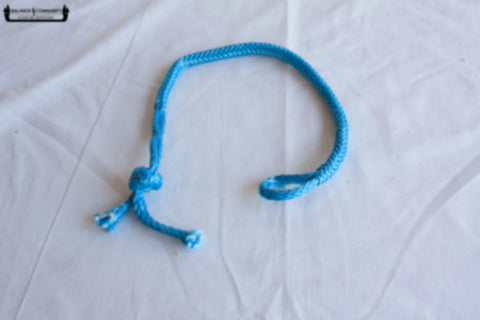

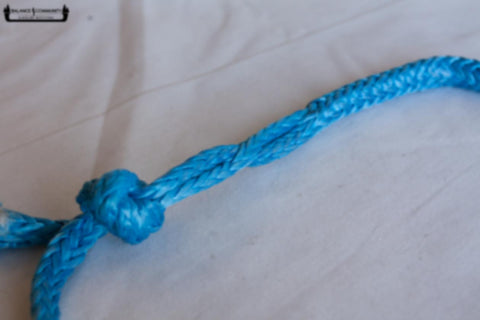

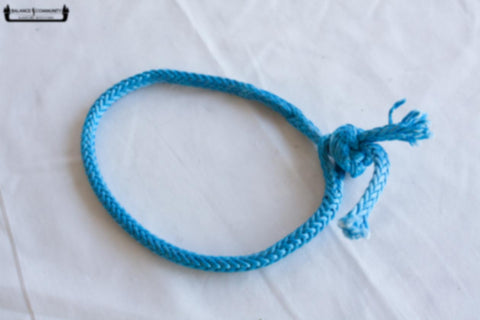
Here is a great guide on creating the entire soft shackle using this method: http://www.animatedknots.com/softshackle/
Here is a nice video on how to create a beautiful soft shackle using this method: https://www.youtube.com/watch?v=jH66tGsWv_Y
Here is a calculator for determining how much rope is needed: http://www.animatedknots.com/softshackle/ (scroll down)
PROS
CONS
Average Strength: 144% of single line strength
This method uses the same knot as method 1 but has a different noose style to allow for easier opening and closing.
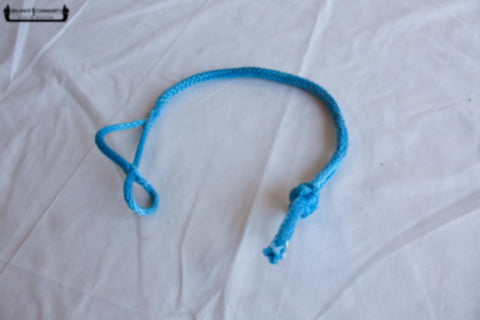
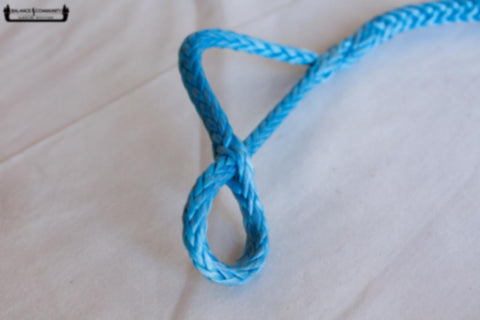


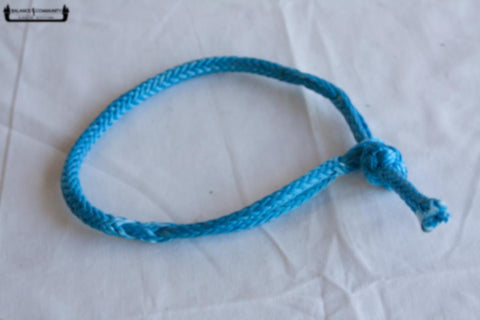
Here is a guide on how to create this type of soft shackle: http://www.animatedknots.com/softshackleedwards/
Here is another guide that has a calculator for line lengths: http://l-36.com/soft_shackle_9.php
Here is a video on how to make them: https://www.youtube.com/watch?v=s8QJEdYqe_E
PROS
CONS
Invented by Brion Toss.
Average Strength: 219% of single line strength
The button knot is a variation on the diamond knot that increases the strength of the knot as well as adds girth to the body of the shackle where the noose wraps around. These 2 things combined allow this method of soft shackle to retain a much higher percentage of strength compared to the other methods above. This is the method we use for our professionally made Soft Shackles in the shop.
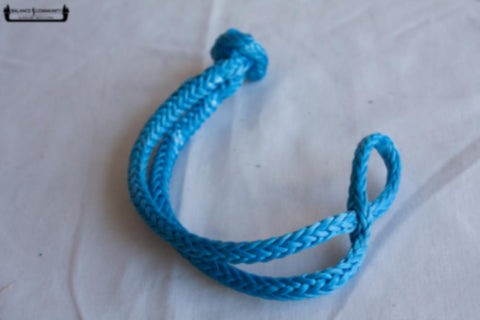
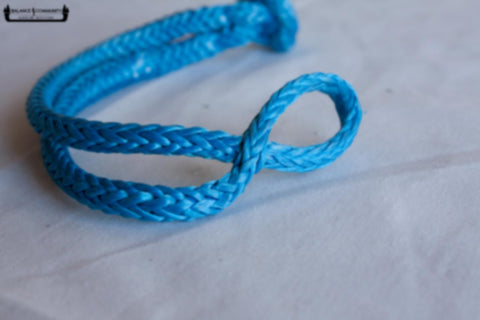
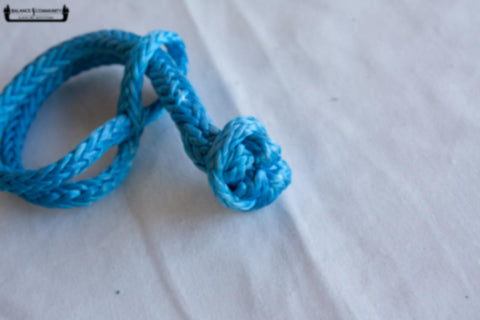
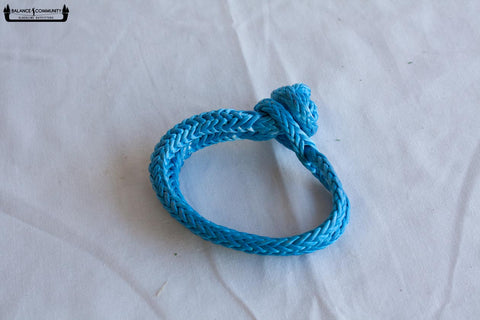
It is especially important to tuck the tails after setting the knot with this variety as it is needed for a high strength retention. It's also extremely important to have the leg lengths be the same. There can be a large variation in strength if these 2 rules are not followed.
Here is more information on this type of soft shackle: http://l-36.com/high_strength_soft_shackle.php
Here is a guide on how to tie the button knot: http://l-36.com/button_knot_top.php
Here is another guide on how to tie the button knot: http://www.bethandevans.com/pdf/button.pdf
Here is a video on how to make these types of shackles: https://www.youtube.com/watch?v=SLhQlJqfjEM
PROS
CONS
Average Strength: 223% of single line strength
This is another method that is much stronger than the Diamond Knot methods above. It uses a very large overhand knot at the end of the shackle with 2 spliced loops on each tail. This makes a very large stopper knot and increases the diameter of the body of the shackle where the noose goes around. In tests, this is showing a similar strength to the button knot, but has a few downsides that make it not the best solution.
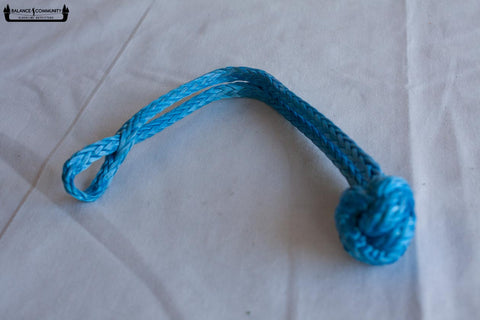

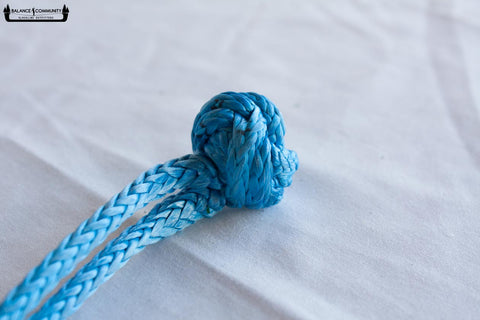
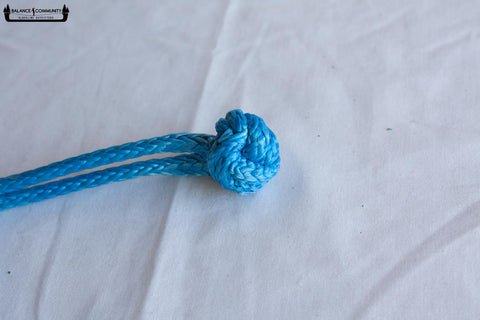

It's vital to make sure the tucked tails extend out beyond the overhand knot into the body of the shackle. This is to ensure the noose wraps around a second of the line that has tucked tails. This will increase the diameter of this section of the shackle, thus increasing the strength retention.
You can see a document on how to build this type of soft shackle here: http://www.bethandevans.com/pdf/improvedsoftshackle.pdf
This method requires you create 2 eye splices: one on either end. Here are instructions for doing this: http://www.animatedknots.com/longbury/
PROS
CONS
We will start with a length of 3/16" Amsteel Blue rated at a breaking strength of 5,400 lbf by Samson Ropes (seen here: Amsteel Blue). We will be making 5 shackles of each variety.
This size of Amsteel is exceptionally small for this type of application. We had to use a small size due to the capacity of the break test machine. If you are thinking of making your own soft shackles, USE 5/16" AMSTEEL! This will ensure you have a strong enough connector for any type of line you rig.
Using the exact same length of rope for each soft shackle (48 inches), we will use the Diamond Knot technique (shown here: http://www.animatedknots.com/softshackle/) to make these soft shackles.
Each soft shackle will have the knot set to 2,000 lbf using the break test machine, all during the same evening.
We will report the breaking strength of the soft shackles in "% of line strength", using the rated value of 5,400 lbf as our "line strength". We will also be testing this line strength value by doing a simple spliced loop test between two 5/8" shackles.
Each shackle variety will be pull-tested between two 5/8" shackles on the same day to ensure the same testing environment.
The results of this test will be observed and described below. No statistical analysis will be run on these results.
Here is a table with the results of our tests:
| Group | Sample 1 | Sample 2 | Sample 3 | Sample 4 | Sample 5 | Average | % Line Strength |
|---|---|---|---|---|---|---|---|
| Spliced Loop | 5,150 lbf (22.9 kN) | 4,796 lbf (21.3 kN) | 5,708 lbf (25.4 kN) | 6,124 lbf (27.2 kN) | 5.874 lbf (26.1 kN) | 5,530 lbf (24.6 kN) | 102.41% |
| Diamond Knot | 8,000 lbf (35.6 kN) | 8,200 lbf (36.5 kN) | 6,800 lbf (30.2 kN) | 7,800 lbf (34.7 kN) | 6,900 lbf (30.7 kN) | 7,540 lbf (33.5 kN) | 139.63% |
| Better Diamond Knot | 8,800 lbf (39.1 kN) | 6,800 lbf (30.2 kN) | 8,700 lbf (38.7 kN) | 7,400 lbf (32.9 kN) | 8,200 lbf (36.5 kN) | 7,980 lbf (35.5 kN) | 147.78% |
| Button Knot | 13,500 lbf (60.1 kN) | 12,100 lbf (53.8 kN) | 12,000 lbf (53.4 kN) | 10,000 lbf (44.5 kN) | 13,000 lbf (57.8 kN) | 12,120 lbf (53.9 kN) | 224.44% |
| Big Overhand Knot | 11,300 lbf (50.3 kN) | 13,500 lbf (60.1 kN) | 11,500 lbf (51.2 kN) | 13,000 lbf (57.8 kN) | 7,000 lbf (31.1 kN) | 12,325 lbf (54.8 kN) | 228.24% |
As you can see, the variance within each group is big! We had one strange occurrence with the big overhand knot where the knot pulled through itself. This particular method is very delicate and requires a perfect tie.
We had the most variance with the Button Knot method, mainly due to the one low value. I suspect this is due to a non-uniform loading during the test. This could have easily been fixed by setting the shackle up better before the test.
The method with the most consistent results is the Diamond Knot. It also shows the least strength of the varieties.

Control Samples
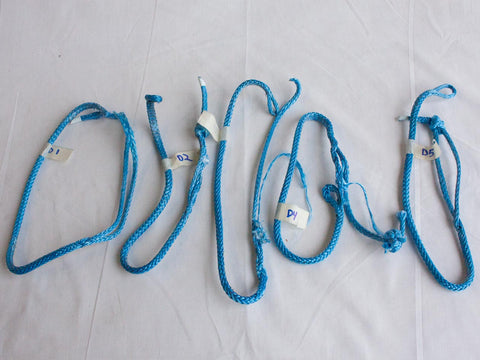
Diamond Knot Samples
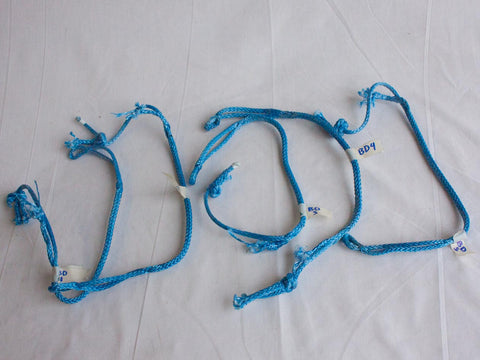
Better Diamond Knot Samples

Button Knot Samples
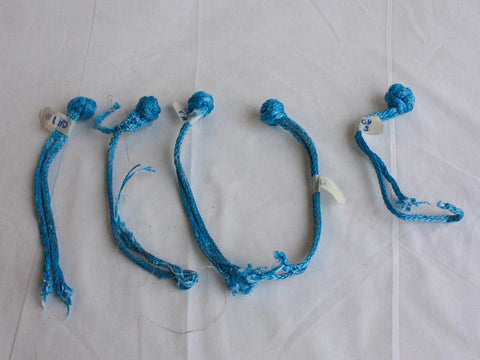
It's great to see how well each method holds up in the strength testing. With as little information there is online about the various methods, it was nice to have some concrete numbers behind some of the tying methods. It's hard to say which method is best from the data above alone. With some practical use testing, which I have also done, it's quite clear which method is the best (the button knot). However, there is more to it than just strength and usability, especially if you are making your own. The relative difficulty in tying each variety plays a huge role in what style you should use.
If strength is a huge issue, the option to use a larger size rope will always be a good way to ensure this. No matter what variety you use, 5/16" Amsteel Blue will be plenty strong for any slackline application.
← Older Post Newer Post →
4 comments
Thank you very much for these experiments and information. I found it very useful. I will go for the button knot. Maybe the variations in strength are caused by tensioning the knot different.
Hi,
thaks for the test!
You write that ”We had one strange occurrence with the big overhand knot where the knot pulled through itself” but from the samples it looks like all overhand knots are broken. The fourth button knot sample looks like it is intact.
I wonder if it was in fact the button knot that pulled through the loop. I have tied a couple of overhands and I find it strange it would go through because the knot is so huge.
Kindly,
Santeri
Hey Paul,
We now use the sheath from a 14mm arborist rope for our sleeving. You can see pictures on our Soft Shackle page here: https://www.balancecommunity.com/products/soft-shackle-6mm?variant=19271557513285
Hi There
What sort of sleeve material is used on the soft shackles to assist with abrasion resistance?
Regards Paul